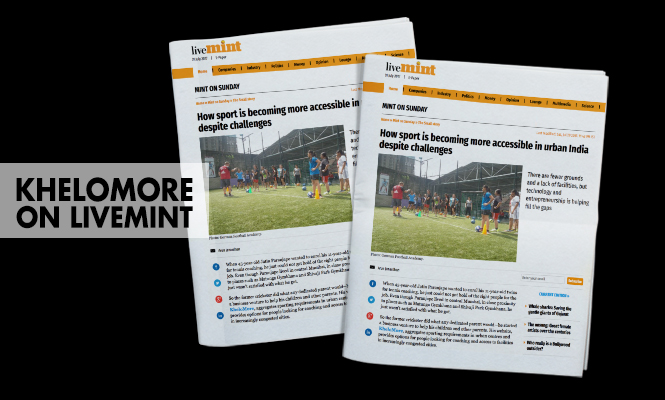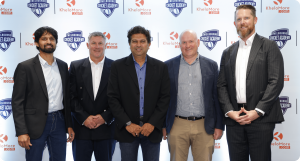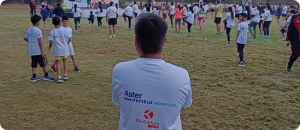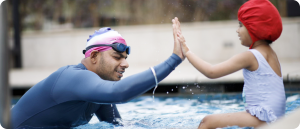How sport is becoming more accessible in urban India despite challenges – LiveMint, 29th July, 2017

There are fewer grounds and a lack of facilities, but technology and entrepreneurship is helping fill the gaps
Arun Janardhan
 Photo: German Football Academy.
Photo: German Football Academy.The public open space available per person in Mumbai is approximately 1.24 sq. metres while for Delhi it is 4.5 sq. metres. A 2011 article by real estate consultancy firm Jones Lang LaSalle had given the Mumbai figure as 1.95 sq. metres, which could mean that open spaces have further reduced in five years. This does not compare favourably with other major cities worldwide, like London, which has about 31.68 sq. metres of open space per person, and New York (26.4 sq. metres).
Concerted effort
Another entrepreneurial example is Germinati Sportz Pvt. Ltd, which has started the German Football Academy (GFA), which brings in German coaches to camps in Pune and Kolkata. The firm plans to expand to four more cities by the end of the year and aims to enrol about 10,000 children in two years.
“What the children should feel is that they are getting international standard training. If we get the mandate, we will send four children to Germany every year,” says Chetan Chavan, who co-founded Germinati with Krish Roy.
Children who enrol in the camp pay Rs1,800 (Kolkata) to Rs2,500 (Pune) a month. GFA, which started in April, hires school grounds and conducts separate classes for boys and girls.
 Photo: German Football Academy.
Photo: German Football Academy.Some others, like KheloMore, are also aggregating facilities—these include Athletto, which is present in eight cities and offers five sports, and Gurgaon-based goSporto, which provides access to about 18 sporting disciplines.
The ambitions of KheloMore and Germinati seem logical in a Rs1,200 crore amateur sports market, as estimated by SportzConsult, a sports management company. Germinati’s Chavan, for instance, expects to break even in two years.
For years, Indian athletes have pointed out to the lack of infrastructure and faults in coaching. To cite a but few recent examples, this includes badminton player Saina Nehwal, Olympian hockey player Viren Rasquinha and shooter Heena Sidhu.
In most cramped Indian cities, there is a constant friction between people’s interest in playing sport and the services available. In addition, it’s not always easy for working men and women to find playing partners, particularly if they are new to the city. And many children are left to play hide and seek in building corridors because several schools and neighbourhoods do not have adjoining playgrounds.
The benefits of play are also hugely underrated in India. “I want to play because it keeps you mentally fit,” says 15-year-old Class IX student Trinisha Banerjee. “When I start to study, I have a fresh mind because I played football earlier.”
The significance of unstructured play cannot be ignored. There are two ways to become a world-class football player, argues Michael Sokolove in a 2010 article in The New York Times. “One is to spend hours and hours in pickup games—in parks, streets, alleyways—on imperfect surfaces… This is the Brazilian way and also the model in much of the rest of South America, Central America and the soccer hotbeds of Africa. The other way is the Ajax method. Scientific training.”
Children in Brazil, for example, are known to have played over 10,000 hours of football by the time they are 13—about 22 hours a week from the age of five—according to SportzConsult.
“I am trying to be perfect in football,” says Banerjee from Kolkata, who has joined a football academy because they have classes for girls.
Haves and have-nots
If there is not enough available open space in cities, the problem is increasingly getting worse too—under constant threat from real estate and infrastructural projects. In Mumbai, for example, which is heavily built up and has few open spaces, the new metro rail project has further eaten into grounds.
The Mumbai Metro Rail Corporation (MMRC) was given nearly 1 million sq. ft of Azad Maidan—one of the four famous grounds of south Mumbai, popular with schoolchildren and aspiring cricketers. The metro has taken so many plots reserved for cricket that the whole Azad Maidan may become unfit for the sport, The Times of Indiareported recently. The grounds are also used for the Mumbai Cricket Association’s monsoonal Kanga League.
The state sports department has also complained that the MMRC has encroached upon at least 5,000 sq. metres of land at the ground, in addition to the 718 sq. metres given to it. In all, according to reports, 7,400 sq. ft of the 1 million sq. ft (200,000 sq. metres) Azad Maidan will be permanently lost (about 300,000 sq. ft or 16% of the space will be used up temporarilytill the work is completed).
The sports department has about 10-15 grounds under its jurisdiction, which they are protecting, says Nagash Mote, the deputy director. He says more grounds are required for a city like Mumbai but are unavailable. There are many under management of the city’s municipal corporation, which have not been developed appropriately, Mote adds.
Under this scenario, Paranjape is also partnering with the state administration in running some of its facilities in and around Mumbai, managing academies there and training coaches. This would also allow for grounds currently associated with certain schools and colleges to be accessed by others.
“If the supply of coaches does not improve, we are in trouble,” he says.
Paranjape adds that people today want their children to play sports and are less stuck up about it.
In Kolkata, Kriti Singhania is one such parent, mother to six-year-old Kabir. She was looking for a contact sport for her child, who was shy and not physically active, but to no avail. “Either the timings would not match or places had one solution to fit all,” she says over the phone.
Now, Kabir has been playing with GFA for two months and is “loving it”. “He has found camaraderie with the guys, the whole team spirit. He is not a great player yet, but he comes back full of these stories. We want him to learn from the sport, not just learn the sport,” says Singhania.
“It’s hard to inspire someone who is not into it, and I don’t want to push him, but there’s something (about football) that’s attracted him. He is very eager to go,” she adds.
Banerjee, the 15-year-old football player, shares the enthusiasm: “I think will play till I am old lady.”





